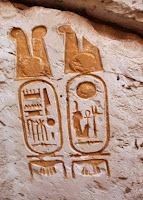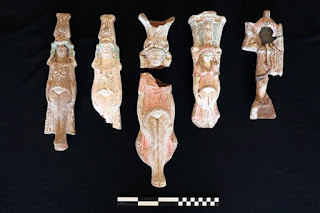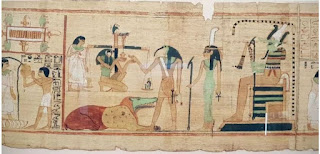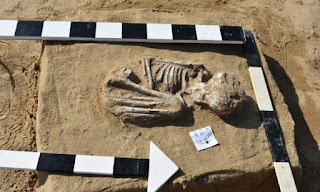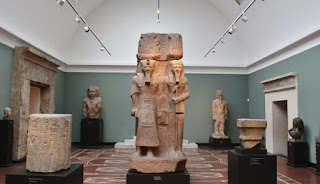Monday, November 25, 2019
Ancient Egypt News 11/25/2019
Cleopatra VII: Scholar, Patron, Queen
Photo: The British Museum
Alexander the Great conquered Egypt in 332 BCE, altering the political panorama of the eastern Mediterranean and the ancient Near East for the centuries to come. One of Alexander's generals, Ptolemy Lagos, identified Egypt as one of the richest areas of Alexander’s empire. He first served as regent for Alexander’s half-brother, Philip, and his son, Alexander IV, but soon took over the throne himself, inaugurating a new dynasty that would endure the next three centuries. All the subsequent kings in the dynasty bore the name Ptolemy after Ptolemy Lagos, distinguishing themselves with different epithets.
As notable as the Ptolemaic kings were the queens of the period. The queen whose memory has persisted as the most notorious character of this period after Alexander himself is Cleopatra VII. The daughter of Ptolemy XII, Cleopatra ruled as the last monarch of the dynasty before Egypt became a province of the Roman empire.
Digging into Ancient Egyptians' Fascinating Coffins World
While the ancient Egyptians believed in the sanctity of afterlife, their coffins expressed those beliefs in the most heart capturing, mesmerising way. The Pharaonic coffins' alluring colours, the sharpness of their details, and their perfectly shaped designs summed this civilisation's glorious eminence.
With the aim of presenting a deeper look into the world of fascinating ancient Egyptian tombs, the Bibliotheca Alexandrina (BA) held a workshop for 40 museum curators and conservators. Under the title 'Understanding Ancient Egyptian Wooden Coffins', the workshop provided participants with a practical training on the examination, carpentry, and construction of ancient coffins.
Photography’s Potential as Art and Science in Documenting Ancient Egypt
John Beasley Greene (1853) the Metropolitan Museum of Art, New York
Signs and Wonders: The Photographs of John Beasley Greene features photographs that focus on ancient monuments and landscapes in Egypt and Algeria from the 1850s, rather than people.
Ancient Egypt has turned up in some unexpected museum exhibitions this year. First, there was the Pulitzer Arts Foundation’s Striking Power: Iconoclasm in Ancient Egypt, followed by the Freud Museum London’s exhibition on Freud’s fascination with Egypt. Now the San Francisco Museum of Modern Art has opened Signs and Wonders: The Photographs of John Beasley Greene, featuring photographs of ancient monuments and landscapes in Egypt and Algeria from the 1850s.
For more on this artist, see The Strange Emptiness of Egypt in 19th-Century European Photographs.
Archaeologists Discover Hidden Palace Marked With Symbols Of Ramesses The Great
An Egyptian palace was discovered on the same site as Ramesses II’s adjacent Temple by New York archeologists.
The palace and temple are located at the ancient site of Abydos, Egypt, where numerous kings are also buried.
Archaeologists were excavating in and around the temple when they discovered the palace
Ptolemaic-era Temple Discovered in Sohag
Photos by Mahmoud Khaled and Mohamed el-Shahed AFP
Archaeologists have discovered a 2,200-year-old temple in Egypt. It is believed to belong to Ptolemy IV Philopator of the Ptolemaic Kingdom.
The structure of the ancient cemetery was found by chance as excavators supplied sewage lines to the village of Kom Ashqaw in the city of Tama, north of Sohag, according to the Egyptian Ministry of Antiquities' posts on its official Facebook page.
Egypt Officially Criminalizes Climbing the Pyramids
Pyramids (via Divya Thakur’s Flickrstream)
Under new articles in the country’s antiquities protection law, climbing monuments and smuggling antiquities out of the country will result in high fines and jail sentences.
https://hyperallergic.com/528576/egypt-officially-criminalizes-climbing-the-pyramids/
Egypt’s parliament amended its antiquities protection law to impose tougher jail sentences and higher fines for smuggling antiquities out of the country, and for the first time criminalizes climbing the country’s monuments.
Khufu Ship: Five Things You Didn’t Know About Egyptian Pharaoh’s Vessel Buried With Him
The discovery of the Khufu ship – an ancient Egyptian pharaoh’s barge buried inside his funeral pyramid – in 1954 was celebrated by a Google Doodle on May 26th.
The wooden ship is 4,600 years old and was reportedly so well-designed it could still sail if launched back onto the Nile today.
Literary Egyptomania: Eight Authors Who Found Inspiration in Egypt
Source: https://egyptophile.blogspot.com/
https://egyptianstreets.com/2019/11/17/literary-egyptomania-eight-authors-who-found-inspiration-in-egypt/
rom movies to best-stelling novels, it’s easy to conjure a list of authors, filmmakers, photographers and artists who have found inspiration in the coutry’s ancient and modern cultural heritage.
While it may comes as a surprise for many, authors in particular, have always had a fondness for writing about Egypt while chronicling their travels sailing the Nile and visiting archeological sites.
Egypt’s undeniable impact on the cultural imagination of Western cultures eventually sparked waves of ‘Egyptomania’ , a term coined in allusion to the specific flourishing and renewed interest in ancient Egypt after Napoleon’s ‘Egypt’ campaign took place in the 18th-19th century.
Photos: The Egyptian Museum celebrates its 117th anniversary
The Egyptian Museum celebrated its 117th anniversary on Friday with a ceremony attended by Minister of Antiquities Khaled al-Anany, the Governor of Cairo, five current and former ministers, and 40 foreign and Arab ambassadors.
Magnificent Egyptian Catacomb Reveals Carvings of a 'Worthy' Woman and Her Pet
Image credit: Egypt Ministry of Antiquities
Almost 2,000 years ago, at a time when the Romans ruled Egypt, a woman named "Demetria" was laid to rest in a magnificently decorated catacomb at Saqqara in Egypt.
A carving found in the underground tomb appears to depict Demetria wearing an elaborate dress while carrying grapes. Some sort of pet looks up at her, with two of its paws on her dress.
Monday, November 18, 2019
Ancient Egypt News 11/18 2019
World's Oldest Cheese: A 3,200 Years Old Cheese Found In An Egyptian Tomb
Scientists from the University of Catania and Cairo University found a solidified whitish mass in a jar, left in an Egyptian tomb. The substance turned out to be a 3,200 year old piece of cheese, among the oldest ever discovered.
A few years ago a team of archaeologists cleaning sand from an ancient Egyptian tomb discovered a group of broken jars, one of them containing a mysterious white substance. The team had guesses as to what the material might be, but a new analysis published in the journal Analytical Chemistry offers an answer: what they found during that excavation was an approximately 3,200 year old piece of cheese, one of the oldest solid specimens discovered
Found: Surprisingly Modern Paint on an Ancient Egyptian Gate
How did a pigment that Vermeer used in the 1600s wind up on Egyptian art from the 6th century BC?
THE PHARAOH APRIES WAS NOT exactly popular. He lost his kingdom to someone who, according to Herodotus, once farted in his face, and in 570 BC was strangled by the Egyptians he once ruled. But he had an excellent palace. Built in the northern part of the ancient Egyptian city of Memphis, Apries’s palace was a sprawling 524 feet by 354 feet. The Pharaoh would enter the grounds through an enormous gate decorated with seven limestone reliefs, one of which depicted the pharaoh under a star-filled blue sky. Other scenes have been lost to time.
Egyptian sculpture about 2686 BC – AD 396
Travel back through 3,000 years of Egyptian history and come face-to-face with the Rosetta Stone and the Statue of Ramesses II.
The objects in the Egyptian sculpture gallery represent three millennia of pharaonic history. The displays have evolved with the field of Egyptology itself.
Modern Egyptology began with a French scientific expedition accompanying Napoleon's invasion of Egypt in 1798. After the British defeated the French, they took some of their most important finds, including the Rosetta Stone and the sarcophagus of the last Egyptian pharaoh, both displayed here.
A German Museum Tried To Hide This Stunning 3D Scan of an Iconic Egyptian Artifact. Today You Can See It for the First Time
After a three-year freedom of information campaign, everyone can finally see the Egyptian Museum of Berlin’s official scan of the Bust of Nefertiti.
For more than a decade, museums around the world have been making high-quality 3D scans of important sculptures and ancient artifacts. Some institutions, such as the Smithsonian and the National Gallery of Denmark, have forward-thinking programs that freely share their 3D scans with the public, allowing us to view, copy, adapt, and experiment with the underlying works in ways that have never before been possible. But many institutions keep their scans out of public view.
Archaeology Breakthrough: Scientists Unravel Major Discovery that Redefines Ancient Life
Image: AFP
SCIENTISTS have used advanced technology to scan the bones of ancient humans in an attempt to understand their daily lives.
The experts utilised modern technology to shine a light on what daily life was like in ancient Egypt in a never before seen study. Using lasers, X-rays and infrared tools, scientists have been able to scrutinise and examine the bones of mummies to better understand our ancestors.
Ancient Egyptians Sacrificed and Mummified Millions of These Sacred Birds—Here's How They Gathered So Many
WASEF ET AL, 2019
The ancient catacombs of Egypt contain millions of mummified birds of the species Threskiornis aethiopicus—better known as the African sacred ibis. Now researchers have cast new light on how the Egyptians obtained so many of these animals—something that has long puzzled experts.
The Egyptians commonly sacrificed and mummified these birds between 665 B.C. and 250 A.D. in honor of the god Toth—who was often depicted as a man with the head of an ibis.
Photos: 3,400-Year-Old Tomb Along Nile River
(Image credit: AcrossBorders project/Julia Budka)
A tomb dating back around 3,400 years has been discovered on Sai Island, on the Nile River in Sudan. The tomb has multiple burial chambers, which contain the remains of more than a dozen, possibly mummified, individuals. The tomb was constructed at a time when there was an Egyptian settlement and gold mine on the island. This picture shows some of the artifacts found in the tomb, including a stone shabti, meant to do the work of the deceased in the afterlife.
Egyptian Museum opens in Rio Grande do Sul
Egyptian artist and businessman Essam Elbattal established in Canela in the Serra Gaúcha a museum with a pharaonic setting of Ancient Egypt. Venue features an internal pyramid with sarcophagus and hieroglyphs. Visitors may dress up in tunics, wigs and turbans.
Canela’s Egyptian Museum comprises a 3,000-square-meter plot and over 1,200 square meters of building area, with sculptures, busts, pieces, and mortuary chambers that refer to the history of the great pharaohs, queens and figures of Ancient Egypt, including Tutankhamun, Ramesses II, Akhenaton, Cleopatra, and Nefertiti.
Egypt Discovery: Historian's Stunned Reaction to 'Oldest Tomb of His Career' Revealed
Image: CHANNEL 5
The discovery came after Tony Robinson joined archaeologist Dr Vasko Dobrev who had uncovered more than 60 tombs in his quest to find the missing Pharaoh Userkare, who he believes is buried in an unfinished pyramid below Saqqara. The suspected burial site served as the necropolis for the Ancient Egyptian capital of Memphis and is home to numerous other pyramids including the Step Pyramid of Djoser. Dr Dobrev has spent the last three decades probing the area just 19 miles from the world-famous Giza Plateau and he now thinks he is closer to hitting the jackpot.
New Discoveries in Egyptology (September-October 2019)
Photo: Ahram
Every two months, the Nile Scribes bring you summaries of the latest research and discoveries in Egyptology, both from the field and the archives. We introduce you to the newest archaeological finds or rediscovered artefacts from museum collections, plus other new theories stirring in the Egyptological Zeitgeist. While few excavations take place in Egypt during the heat of the summer, there has nevertheless been a number of exciting discoveries announced at the outset of the cooler, post-summer months. The world’s attention was recently captured by the discovery of a new cache of Twenty-Second Dynasty mummies at Asasif in Luxor.
A Nile Journey Into the Past
Credit...Boyer/Roger Viollet, via Getty Image
In the 19th century, women explorers sailed the Nile, sending back vivid accounts of Egypt’s riches. A 21st-century writer travels in their wake.
Huddled on a chaise on the upper deck of the Orient, the dahabiya that I had chosen for a cruise down the Nile, I sipped hibiscus tea to ward off the chill. Late in February, it was just 52 degrees in Aswan, where I had boarded the sailboat, but the scenery slipping past was everything the guidebooks had promised: tall sandbanks, curved palms and the mutable, gray-green river, the spine of Egypt and the throughline in its history.
‘Ancient Wonders’ With a Future
PHOTOGRAPHS BY DEAN KEEFER
The Museum of Ancient Wonders opens in Cathedral City with replicas of King Tutankhamun artifacts, African masks, and prehistoric fossils.
A modest strip mall at the corner of Highway 111 and Date Palm Drive is an unlikely place for King Tutankhamun’s golden chariot and the skull of a T-Rex, but Alberto Acosta and Joe McCabe are making it work. The Museum of Ancient Wonders, the Coachella Valley’s newest cultural attraction, opened Oct. 26, showing a portion of Acosta’s extensive collection of replicas of Egyptian antiquities and dinosaur fossils, along with artistic recreations of African masks representing 3,500 years of tribal ritual and mysticism.
Ancient Greek and Roman Cemetery Discovered in Egypt
Credit: ET
The Egyptian Ministry of Antiquities announced recently that an ancient Greek and Roman cemetery has been discovered in Ismailia.
According to reports, the cemetery has multiple levels. The upper levels date back to ancient Greek and Roman times, while the lower are from Egypt’s pre-dynastic eras.
Egypt Says It’s Unearthed Large Animal Mummy, Likely a Lion
Egypt’s Ministry of Antiquities says local archeologists have unearthed the mummy of an unusually large animal, most likely a lion or lioness. The ministry said on Monday the mummy was excavated in Saqqara, a town south of Cairo that was a vast necropolis in antiquity and is home to the famed Step Pyramid.
Here's a more comprehensive article from NBC that came with this photo. This mummified lion was found in the tomb on King Tut's wet nurse. The colored scale has been placed next to it for measurement purposes.
P. Chapuis / MAFB. Copyright Hypogees
Ahnaten at the Met Trailer
Reviews:
Monday, November 11, 2019
Ancient Egypt News 11/11/2019
I Know This Place Podcast
Series 1, episode five of I Know This Place takes a trip into the past with Egyptologist Kara Cooney
Episode: 5 Featuring Ute Junker and Dr Kara Cooney
The pyramids at Giza are simply awe-inspiring; but they are just the start. Egypt is home to a dazzling collection of ancient tombs and temples, some of which date back 5000 years. Egyptologist Dr Kara Cooney talks us through ancient Egypt’s don’t-miss destinations, and tells us more about the intriguing civilisation that built these incredible monuments.
Were Egyptian Pyramids Used to Bury Dead Kings?
Source Picturesque Egypt by Georg Ebers 1885.
The answer according to the current scientific evidence is … YES (no, I'm not shouting)
Because that is how archaeology works, we collect evidence from as many sources as possible, and if it all points in one direction we draw conclusions. The pseudo crowd bleating that we all follow the party line in an elaborate cover up may work for politicians (looking at world politics consider me sceptical), but in science a whole bunch of fields rely on accumulating evidence … no evidence = no theory.
… or rather you can have as many theories as you like at home over a cabernet sauvignon, but for anybody with half a brain to believe them you have to prove it in writing, with evidence.
How A Pair Of Sandals Makes An Ancient Queen 'A Presence' In A Kansas City Exhibition
CREDIT MUSEO EGIZIO, TURIN
There's a bit of Indiana Jones in everyone, which is why people continue to be fascinated by ancient Egyptians and their tombs, says Julián Zugazagoitia, the Director and CEO of the Nelson-Atkins Museum of Art.
That, he says, and "we all search for immortality in some way or another."
At its core, Zugazagoitia says, Egyptian art is about preserving the "life presence" of a person. Egyptians believed that for the soul to live in the other world, the person needed to have her depiction in sculpture form.
What 3,000-year-old Egyptian Wheat Tells Us about the Genetics of Our Daily Bread
Charles K. Wilkinson/Met Museum of Art
Human societies need food—and that often means wheat, which was first cultivated more than 12,000 years ago. Today, around one in five calories consumed by humans is from wheat. Over this time, humans have moved wheat species around the globe and transformed them through cultivation and breeding.
. . .
In Pharaonic Egypt, emmer was the most common wheat. It is claimed that the Romans therefore referred to hulled wheat as Pharaoh's wheat, which could be the linguistic root of "farro". Egyptians may have found that emmer wheat suited the local climate or that the hulls protected the grain from pests in storage.
Spectacular Relics of Egyptomania You Can Still See in Britain
Britain was fascinated by ancient Egypt long before Howard Carter found Tutankhamun’s tomb, with Napoleon’s Middle Eastern campaign (1798–1801) igniting interest across Europe. Nevertheless, the discovery in 1922 of King Tut’s final resting place sparked a new wave of Egyptomania.
The Met Opera Presents the Company Premiere of Philip Glass’ Akhnaten
Credit: Karen Almond / Met Opera
When Philip Glass’s Akhnaten appeared recently at English National Opera, in a spellbinding production by Phelim McDermott, it quickly became a sold-out sensation. Audiences were enthralled not just by the mesmerizing score but also by the glorious, colorful stage pictures and hypnotic dramatic flow. Anthony Roth Costanzo’s gripping performance of the title role—complete with extended opening nude scene—was hailed as a triumph. The production even incorporated juggling, with choreographer Sean Gandini’s troupe bringing ancient Egypt to life with their virtuoso routines.
Also see Writing Akhnaten.
Inside Ancient Egyptian Cat Mummy, Archaeologists Find Remains of 3 Cats
Credit: Museum of Fine Arts of Rennes
Scans of an ancient cat mummy revealed that the 2,500-year-old feline supposedly resting within the wrappings wasn't a single animal. Instead, the mummy held the partial remains of three cats, according to new findings.
Ancient Egyptian cat mummies aren't uncommon, and archaeologists have previously found tens of cat mummies in burials. In ancient Egypt, pets were commonly buried with their owners. The desire to preserve animals as offerings to the gods led to the establishment of an entire industry and the mummification of over 70 million animals, according to a previous Live Science report.
Tutankhamun Unmasked: 7 Intriguing Truths about the Pharaoh and His Treasures
Photo by Ramin Talaie/Corbis via Getty Images
As the UK welcomes a new exhibition on Tutankhamun's tomb – considered by many the greatest archaeological discovery of all time – mystery still surrounds ancient Egypt's most famous son. Here, Joann Fletcher unearths seven intriguing truths about the pharaoh and his legendary treasures
The Book of the Dead in 3D
Egyptian coffins are inscribed with spells and images which stand in for spells. All function together as a machine to resurrect the deceased and to guide them safely through the next world. Given this function, its perhaps surprising that the texts from coffins are usually published completely divorced from their position on the coffin. Any additional meaning conferred on the texts by their placement on the surrogate body or relative to each other and the vignettes is lost. In order to understand a coffin as a magical machine, it's necessary to view the spells in 3D so that this relationship can be taken into account.
The aim of this project is to explore the relationship between texts and their positioning on a magical object through building annotated 3D models of coffins displaying the texts and translations.
Egyptian Symbols and Their Meanings: A Complete Guide
Ever wondered what those curious Egyptian symbols – hieroglyphs – actually represent? We did the research and compiled a comprehensive list of the most common symbols and their meanings, so that you don’t have to.
As one of the oldest known human civilisations, Ancient Egypt has captured the imaginations of people for centuries. Known for its mummies, pyramids and pharaohs, there are few civilisations as impressive – especially considering that it lasted for an incredible 3000 years.
How did Ancient Egypt thrive for so long? It is believed that religion and written language were largely responsible for the civilisation’s success, as they allowed for ancient knowledge and values to be communicated between generations.
DePaul Professor Preserves Archaeological Artifacts from Egypt
PHOTO COURTESY OF SCOTT BUCKING/BENI HASSAN SOUTH PRESERVATION PROJECT
DePaul does not harbor an especially large history department, let alone a department specifically dedicated to archaeology. As a result, a DePaul student might be surprised to hear that one of their own professors received a $75,000 grant for an archaeological preservation project. However, those who know Professor Scott Bucking were anything but surprised.
“He is irrepressible,” said longtime colleague and Associate Dean Margaret Storey. “He is deeply committed to his field, creative, determined, and he has a passion for what he does,” she continued.
Bucking applied for the grant to preserve a group of archaeological remains in Beni Hassan, a mountainous region of Egypt that sits along the Nile River Valley.
A Guide To International Exhibits On Ancient Egypt
Via Flickr.
The civilization of ancient Egypt has always fascinated all those who came across it, local or foreigner. Spanning for 5,000 years of history, ancient or Pharaonic Egypt had left behind more artefacts than any other civilization in the world, from the colossal Pyramids of Giza to the many sculptures and mummies.
Ever since Egyptology as an interdisciplinary branch of history, archaeology, and science were established, more and more about their history came to be known to the world, and every year around the world, exhibitions about Egypt and its history open door to the public to deliver this knowledge. Here are some of these exhibitions that are making headlines in Autumn.
Subscribe to:
Posts (Atom)




![John Beasley Greene, “Pyramids of Giza, [Mr. Mariette’s site], Excavation to the left of the Sphinx” (1853) John Beasley Greene, “Pyramids of Giza, [Mr. Mariette’s site], Excavation to the left of the Sphinx” (1853)](https://blogger.googleusercontent.com/img/b/R29vZ2xl/AVvXsEiiOVE2ToJMxpe5om_wDoEPPTuV0cxvTHmV89TPTI4UGDHPb57idVFfCTGDRGgh9au8fprOzthd5PfFgrpd2GHHsGF64YP_n1SYJfZ8y5qOKlohg0151xH5ODrMSatsjzj0Vfpt15CYsNyE/s320/4-Mariette-Michael-Press-SFMOMA-720x558.jpg)
